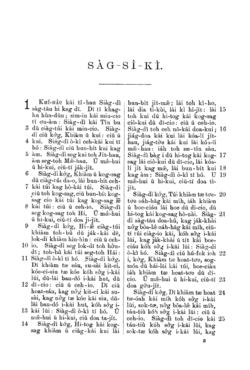Hainanese
Hainanese (Hainan Romanised: Hái-nâm-oe, simplified Chinese: 海南话; traditional Chinese: 海南話; pinyin: Hǎinánhuà), also known as Qióngwén (simplified Chinese: 琼文; traditional Chinese: 瓊文) or Qióngyǔ (琼语; 瓊語),[3] is a group of Min Chinese varieties spoken in the southern Chinese island province of Hainan. In the classification of Yuan Jiahua, it was included in the Southern Min group, although it is mutually unintelligible with Southern Min varieties such as Hokkien–Taiwanese and Teochew.[4] In the classification of Li Rong, used by the Language Atlas of China, it was treated as a separate Min subgroup.[5] Hou Jingyi combined it with Leizhou Min, spoken on the neighboring mainland Leizhou Peninsula, in a Qiong–Lei group.[6] "Hainanese" is also used for the language of the Li people living in Hainan, but generally refers to Min varieties spoken in Hainan.
| Hainanese | |
|---|---|
| Qiong wen | |
| 海南話, Hái-nâm-oe | |
| Pronunciation | [hai˨˩˧ nam˨˩ ue˨˧] (Haikou dialect) |
| Native to | China |
| Region | Hainan |
| Ethnicity | Hainanese |
Native speakers | Around 5 million in China (2002)[1] |
| Dialects | |
| Chinese characters Hainan Romanized | |
| Language codes | |
| ISO 639-3 | None (mis) |
| Glottolog | hain1238[2] |
| Linguasphere | 79-AAA-k |
 Hainanese | |

Phonology
Hainanese has seven phonemic vowels .
| Front | Central | Back | |
|---|---|---|---|
| Close | /i/ | /u/ | |
| Close-mid | /e/ | /o/ | |
| Open-mid | /ɛ/ | /ɔ/ | |
| Open | /a/ |
Hainanese notably has a series of implosive consonants, which it acquired through contact with surrounding languages, probably Hlai.
| Labial | Dental | Alveolo | Velar | Glottal | ||
|---|---|---|---|---|---|---|
| Nasal | /m/ 目 mak | /n/ 念 niam | /ŋ/ 乐 ngak | |||
| Plosive | voiceless | /p/ 爸 pa | /t/ 洗 toi | /k/ 公 kong | /ʔ/ 啊 a | |
| Aspirated | (/pʰ/) 婆 pho | (/kʰ/) 去 khu | ||||
| voiced/implosive | /ɓ/ ɓak 北 | /ɗ/ 茶 ɗei | (/ɠ/) | |||
| Affricate | /ts/ 食 tsia | /dʑ/ 日 Jit | ||||
| Fricative | voiceless | /f/ 皮 fi | /s/ 事 sei | /x/ 去 xu | /h/ 海 hai | |
| voiced | /v/ 文 vun | /z/ 欲 zok | /ɦ/ | |||
| Approximant | (/w/) 发 wat | /l/ 老 lao | (/j/) 肉 yok | |||
The phonological system of Hainanese corresponds well with that of Hokkien, but it has had some restructuring. In particular, etymological *anterior plain stops have undergone implosivization (*p > [ɓ], *t > [ɗ], etymological *aspirated stops have spirantized (*pʰ > [f], *tʰ > [h], *cʰ > [ɕ] *kʰ > [x]), and etymological *s have hardened into stops (*s > [t]), and *h > [ɦ]. Additionally, some dialects have [ɡ], and [ʑ] is allophonic with /j/.
See also
- Hainanese culture
- Hainanese people
References
- Hou, Jingyi 侯精一 (2002). Xiàndài hànyǔ fāngyán gàilùn 现代汉语方言概论 [An Introduction to Modern Chinese Dialects]. Shanghai Educational Press 上海教育出版社. pp. 207–208.
- Hammarström, Harald; Forkel, Robert; Haspelmath, Martin, eds. (2017). "Hainan". Glottolog 3.0. Jena, Germany: Max Planck Institute for the Science of Human History.
- "为新加坡琼属"寻根"的热心人——王振春". Hainan.gov (in Chinese). 中新海南网. Retrieved 22 March 2020.
他组织演出琼语话剧《海南四条街》,搬上新琼舞台,引起两地海南人的共鸣。
- Simons, Gary F.; Fennig, Charles D., eds. (2017). Ethnologue: Languages of the World (20th ed.). Dallas, Texas: SIL International. Chinese, Min Nan.
- Kurpaska, Maria (2010). Chinese Language(s): A Look Through the Prism of "The Great Dictionary of Modern Chinese Dialects". Walter de Gruyter. pp. 54–55, 86. ISBN 978-3-11-021914-2.
- Hou, Jingyi 侯精一 (2002). Xiàndài hànyǔ fāngyán gàilùn 现代汉语方言概论 [An Introduction to Modern Chinese Dialects]. Shanghai Educational Press 上海教育出版社. p. 238.
Further reading
- Chang, Kuang-yu (1986). Comparative Min phonology (PhD thesis). University of California, Berkeley.
- Chen, Hongmai (1996). Hǎikǒu fāngyán cídiǎn 海口方言詞典 [Haikou dialect dictionary]. Great Dictionary of Modern Chinese Dialects. 16. Nanjing: Jiangsu Education Press. ISBN 978-7-5343-2886-2.
- Huang, Karen. "Contact-induced changes in the languages of Hainan". Annual Student Conference of the College of Languages, Linguistics, and Literature. University of Hawaii.
- Kwok, Bit-chee (2006). "The role of language strata in language evolution: three Hainan Min dialects". Journal of Chinese Linguistics. 34 (2): 201–291. JSTOR 23754124.
- Miyake, Marc. 2008. Hainanese articles.
- Miyake, Marc. 2008. Hainanese -om and -op.
- Norman, Jerry Lee (1969). The Kienyang Dialect of Fukien (PhD thesis). University of California, Berkeley. includes a description of the phonology of the Ding'an dialect.
- Solnit, David B. (1982). "Linguistic Contact in Ancient South China: The Case of Hainan Chinese, Be, and Vietnamese". Proceedings of the Eighth Annual Meeting of the Berkeley Linguistics Society. 8: 219–230. doi:10.3765/bls.v8i0.2041.
- Woon, Wee-Lee (1979a). "A synchronic phonology of Hainan dialect: Part I". Journal of Chinese Linguistics. 7 (1): 65–100. JSTOR 23753034. describes Wenchang dialect.
- Woon, Wee-Lee (1979b). "A synchronic phonology of Hainan dialect: Part II". Journal of Chinese Linguistics. 7 (2): 268–302. JSTOR 23752923.
- Yan, Margaret Mian (2006). Introduction to Chinese Dialectology. LINCOM Europa. ISBN 978-3-89586-629-6.
External links
| Wikimedia Commons has media related to Hainanese language. |

- Learn hainanese
